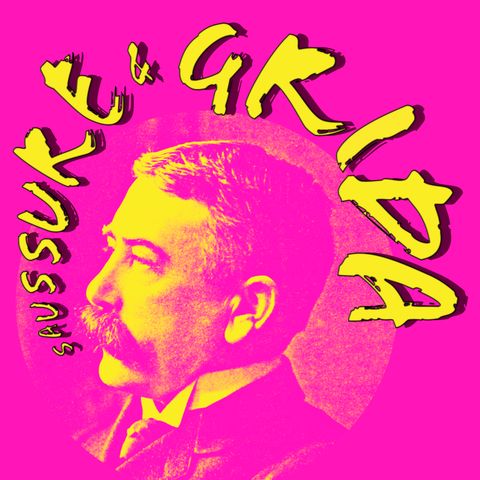13. Di lingue dei segni, LIS e abilismo

Mar 16, 2024 ·
24m 8s
Questo episodio esplora le lingue in modalità visivo-gestuale, smontando alcune credenze diffuse che potrebbero portarci a fraintendere la vera natura delle lingue segnate. Durante la puntata, esamineremo da vicino alcune...
show more
Questo episodio esplora le lingue in modalità visivo-gestuale, smontando alcune credenze diffuse che potrebbero portarci a fraintendere la vera natura delle lingue segnate. Durante la puntata, esamineremo da vicino alcune caratteristiche generali e alcune peculiari della LIS, la lingua dei segni italiana, al fine di evidenziare che le lingue dei segni hanno strutture proprie, completamente diverse dalle lingue parlate. È fondamentale comprendere, infatti, che le lingue dei segni sono sistemi linguistici autonomi, che pur nella loro unicità condividono comunque affascinanti fenomeni evolutivi con tutte le altre lingue del mondo, indipendentemente dalla loro modalità.
Grafiche: Gianluca La Bruna
La sigla è stata prodotta da White Hot e fornita da https://freebeats.io
FONTI:
show less
Grafiche: Gianluca La Bruna
La sigla è stata prodotta da White Hot e fornita da https://freebeats.io
FONTI:
- Cardinaletti, A., & Repetti, L. (2008). Vocali epentetiche nella morfologia dell’italiano e dei dialetti italiani. In R. Maschi, N. Pennello, & P. Rizzolati (Eds.), Miscellanea di studi linguistici offerti a Laura Vanelli da amici e allievi padovani. Udine: Forum Editrice. 24.
- Cecchetto, C., Geraci, C. & Zucchi, S. (2006). Strategies of relativization in Italian Sign Language. Nat Language Linguistic Theory 24:945–975.
- Corbett, G. (2000). Number. Cambridge Textbooks in Linguistics. Cambridge: Cambridge University Press. pp. 26–30
- Corina, D., & Singleton, J. (2009). Developmental social cognitive neuroscience: Insights from deafness. Child Development, 80(4), 952–967.
- Dye, M.W.G., Hauser, P. C., & Bavelier, D. (2009). Is Visual Selective Attention in Deaf Individuals Enhanced or Deficient? The Case of the Useful Field of View. PLOS ONE, 4(5), e5640
- Eberhard, D.M., Simons, G.F., & Fennig, C.D. (Eds.). (2023). Ethnologue: Languages of the World. Twenty-sixth edition. Dallas, Texas: SIL International. Online version.
- Figueras, B., Edwards, L., & Langdon, D. (2008). Executive Function and Language in Deaf Children. The Journal of Deaf Studies and Deaf Education, 13(3), 362–377.
- Fontana, S., Corazza, S., Braem, P.B., & Volterra, V. (2017). Language Research and Language Community Change: Italian Sign Language, 1981–2013. Sign Language Studies, 17(3):363–398.
- Geraci, C. (2012). Language Policy and Planning: The Case of Italian Sign Language. Sign Language Studies, 12(4):494-518
- Kegl, J., & Iwata, G. (1989). Lenguaje de Signos Nicaragüense: A pidgin sheds light on the “creole?” ASL. Proceedings of the Fourth Annual Meeting of the Pacific Linguistics Conference. Eugene: University of Oregon.
- Nuckolls, J.B. (1999). The Case for Sound Symbolism. Annual Review of Anthropology, 28:225-252.
- Ortega, G. (2017). Iconicity and sign lexical acquisition: A review. Frontiers in Psychology, 8, Article 1280.
- Perniss, P., Pfau, R. & Steinbach, M. (2017). Can’t you see the difference? Sources of variation in sign language structure. In P. Perniss, R. Pfau & M. Steinbach (Eds.). Visible variation: cross-linguistic studies on sign language structure (pp. 1-34). Berlin: Mouton de Gruyter
- Perniss, P., & Vigliocco, G. (2014). The bridge of iconicity: From a world of experience to the experience of language. Philosophical Transactions of the Royal Society B, 369, 20130300.
- Petitta, G. (2012). Sordo, sordomuto, non udente nella stampa italiana contemporanea. Bollettino di Italianistica 2:171–183.
- Pinker, S. (1994). The Language instinct: how the mind creates language. London: Harper Perennial.
- Sandler W., & Lillo-Martin D. (2006). Sign Language and linguistic universals. Cambridge: Cambridge University Press.
- Senghas, A. (1994a). Nicaragua’s lessons for language acquisition. Signpost: The Journal of the International Sign Linguistics Association, 7:1.
- Senghas, A. (1994b). The development of Nicaraguan Sign Language via the language acquisition process. In D. MacLaughlin & S. McEwen (Eds.), Proceedings of the Boston University Conference on Language Development, 19 (pp. 543-552). Boston: Cascadilla Press.
- Senghas, A., Kegl, J., Senghas, R.J., & Coppola, M.E.V. (1994). Sign language emergence and sign language change: children's contribution to the birth of a language. Boston, Massachusetts: Poster presented at the Annual Meeting for the Linguistic Society of America.
- Volterra, V. (Ed.). (1981). I segni come parole: La comunicazione dei sordi. Turin: Boringhieri.
- Volterra, V. (Ed.). (1987). La lingua dei segni italiana: La comunicazione visivogestuale dei sordi. Bologna: Il Mulino.
Information
| Author | Irene |
| Website | - |
| Tags |
Copyright 2024 - Spreaker Inc. an iHeartMedia Company
